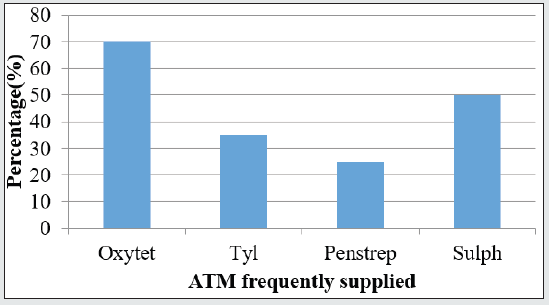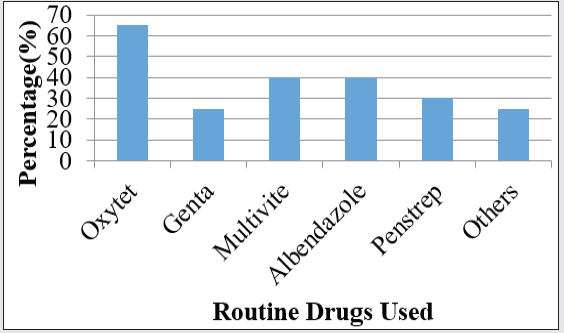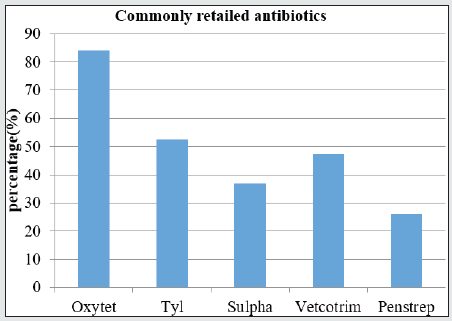
Lupine Publishers Group
Lupine Publishers
Menu
ISSN: 2690-5760
Research Article(ISSN: 2690-5760) 
A Survey on Antimicrobial Supply and Usage by Veterinary Outlets, Farmers and Practitioners in Selected Areas of Kebbi State Volume 3 - Issue 4
AA Ebbo1*, Nazir Sani2, A Bello, JM Bello3, SB Idris1, AA Sani1, L Junaidu2 and OO Gift3
- 1Department of Veterinary Pharmacology and Toxicology, Usmanu Danfodiyo University, Nigeria
- 2Department of Veterinary Anatomy, Usmanu Danfodiyo University, Nigeria
- 3Department of Veterinary Services, Agricultural and Rural development secretariat, FCT Admin, Abuja
Received:August 04, 2021 Published: August 18, 2021
Corresponding author:A A Ebbo, Department of Veterinary Pharmacology and Toxicology, Usmanu Danfodiyo University, Sokoto, Nigeria
DOI: 10.32474/JCCM.2021.03.000169
Abstract
A survey on antimicrobial supply and usage by outlets, veterinary practitioners, and farmers was conducted in selected areas of Kebbi State using three questionnaires of 15, 26, 15 copies respectively. This was by random a sampling technique. The information on various antibiotics used, sources of the antibiotics, and commonly retailed drugs were documented. The study showed that more than half of the respondents (outlets and farmers) were educated at either School Certificate or HND levels, whereas the practitioners are Veterinarians (DVM) within Kebbi metropolis. The study also revealed that the commonly retailed antibacterials by outlets are tetracycline, tylosin, sulphadimidine, vetcotrim® and penstrep®, with tetracycline having the highest percentage (84.2%). On the other hand, the most commonly used antibacterial among farmers is tetracycline (65%), while sulphadimidine is the commonly used drug with 42.30% usage among practitioners. Most of the antibacterials supplied by outlets, practitioners and farmers are sourced from distributors and retailers. In conclusion, this study has provided information on the commonly retailed and used antibiotics, where they were sourced from and who dispensed the drugs. It is recommended that practices such as better hygiene, vaccination and good herd management that may minimize the use of antibiotics be adopted.
Keywords: Antimicrobial; Veterinary practitioners; Farmers; Kebbi State
Introduction
Nigeria is a leading country in the number of animal population in the African continent. However, the output in terms of contributions to the improvement of the livelihood of animal owners and for the growth of the national economy is at a lower stage compared to the vast resource at hand. Poor Animal health services and lack of proper utilization of veterinary antibiotics are among the major contributing factors [1]. A drug is any substance that when inhaled, injected, smoked, consumed, absorbed through the skin, or dissolved under the tongue causes a physiological change in the body. In pharmacology, a pharmaceutical drug is a chemical substance used to treat, cure, and prevent animal diseases or to promote well-being [1]. Veterinary drugs are such substances that are made to treat or prevent animal diseases. These drugs belong to different chemical classes and therapeutic areas, such as antibiotics, anti-helminthics, and non-steroidal anti-inflammatory drugs (NSAIDs), etc. [2]. An antibiotic class can be defined as a group of agents with a similar mechanism of action, regardless of chemical structure [3]. Antibiotic drugs have been widely used globally in animals for more than 50 years, with tremendous benefits in animal production and economic development [1].
Antibiotics are used extensively in both humans and animals worldwide. The increase in the use of antibiotics, as an integral part of the poultry and other livestock production industries to treat and prevent infectious bacterial diseases and as growth promoters, has led to the development of bacterial antibiotic resistance over the years [4]. Rapid and large poultry and livestock production turnout are partly due to improved feeding and health management practices involving usage of antibiotics as therapeutic agents to treat bacterial diseases in intensive farming systems. In both developing and developed countries, the economic and health benefits of using antibiotics have revolutionized intensive poultry and other livestock production. Majority of the antibiotics used in poultry and livestock are for treatment of infections and also to counteract the adverse consequences of stress [3]. Antibiotics used can be divided into two categories: therapeutic antibiotics and growth-promotant antibiotics [5]. Therapeutic dose of antibiotics are used for treatment of bacterial infections. Antibiotics used in feed for growth promotion and disease prevention purposes are administered at levels that are lower than those given for the treatment of diseases, and therefore, these uses are termed subtherapeutic.
These in-feed antibiotics are capable of exerting a selection pressure on bacterial populations and altering various microbial communities [6]. Uses of antibiotics in either category have the potential to select for bacterial strains that are resistant to the antibiotics used while still having a positive impact on the health of the animal population.
The antibiotics in the growth-promotant category are, in some cases, the same antibiotics used in the therapeutic category. The growth-promotant antibiotics are administered in poultry feed [7]. The decision to use growth-promotant antibiotics in commercial poultry and also in livestock is primarily based on economic factors, i.e., whether the improvements in body weight, feed efficiency, and/or growth rates are worth the cost of the antibiotic [8,9]. The successful use of antibiotics in veterinary medicine not withstanding their use has become particularly worrisome, especially for the fact of the potential to pass such drugs into the human food chain. Also the possibility of reduced efficacy of such drugs which has been observed in some reports to be administered by unqualified personnel [10, 11]. In developed countries, stringent control of antibiotic use coupled with effective surveillance of antibiotic resistance patterns in the population have successfully reduced the prevalence of antibiotic resistance to these agents (Collignon, 2003). The situation in the developing countries like Nigeria where antimicrobial agents are readily available to people in local drug stores without prescription is however different [12]. Such practice has led to misuse of antibiotics with the associated high prevalence of antibiotic resistance among bacteria from animal and food sources [13]. In and around Kebbi State metropolis, there is little information regarding veterinary antibiotic drugs handling, supply and utilization practice by outlets, farmers, and practitioners.
Antimicrobials are used extensively in both humans and in animals, the worldwide increase in the use of antibiotics, as an integral part of the livestock production to treat and prevent infectious diseases and as growth promoters has led to the problem of the development of antibiotic resistance.
Poor Animal health service and lack of proper usage of veterinary antibiotics are among the main contributing factors for antibiotics resistance. Antimicrobial chemotherapy has conferred huge benefits on animal and human health [14]. In the current situation, where multidrug-resistant bacteria have spread widely, options for treatment with antimicrobial agents are a major concern. Therefore Antimicrobials used by veterinary outlets and farmers should be sourced from certified drug manufacturers and retailers. Routine veterinary care and drug prescription should be provided by veterinarians. This is not the situation where the use of veterinary drugs without expert supervision is rampant. More also veterinarians in Nigeria should be encouraged to take a front seat in the importation, distribution, sale and administration of veterinary pharmaceuticals. The aim of this study is to come up with an optimal practice in the supply, handling and administration of antibiotics in the selected areas in Kebbi State. The specific objectives of the study include to find out the antimicrobial drugs that are frequently supplied by outlets, to determine the commonly used antimicrobial drugs by farmers and veterinary practitioners and to determine the source of the antimicrobial drugs from outlets, farmers and veterinary practitioners.
Materials And Methods
The study was conducted in Kebbi state, which is in the northwestern Nigeria with its capital at Birnin Kebbi. The study was carried out in selected areas of the state. The State was created out of the old Sokoto State in 1991. It is bounded by Sokoto, Niger, and Zamfara States. Also by Dosso in the Republic of Niger and Benin Republic. It has a total area of 36,800 km2 with a population of close to 3,256,541 (2006 census). Kebbi State is made up of 4 (four) emirates i.e. Gwandu, Yauri, Zuru and Argungu. It lies between latitudes 12o 27’13’’N and 4o12’01’’E.
Study design and data collection
A cross-sectional survey was conducted to collect data for the study. The survey made use of well-structured questionnaires. A total of 90 copies of questionnaires were administered to farmers, veterinary pharmaceutical outlets and veterinary practitioners 30 each, across the state by random sampling technique. The survey information on various antibiotics used, sources of antibiotics, and personnel who administer the drugs were collected and documented. Interviews were also carried out to obtain first-hand information from respondents. The collected data were entered into Microsoft Excel spread sheet version 2010 and processed. The processed data were analyzed using descriptive statistics (%), bar charts and tables to summarize the data. The results were presented in simple frequency (bar chat) with percentages.
Results and Discussion
The number of years of practice
The number of years of practice of outlets, farmers, and veterinary practitioners in Birnin Kebbi shows that those in practice for less than five years are 25%, those in practice between five and ten years are 45% and those in practice above ten years are 30%. The percentage distribution of year of practice for practitioners and farmers are very similar across all the ages as seen in Table 1.
The age category of respondents
The age category of outlet owners less than 30 years is 55% and greater than 30 years is 45%, farmers less than 30 years are 50% and greater than 30 years are 50%, and veterinary practitioners that are less than 30 years are 64% and greater than 30 years are 36% in Birnin Kebbi as shown in Table 2.
The percentage of sources of drugs
The percentage of sources of drugs by outlets 75% from distributors and 25% from retailers, farmers 52.6% from distributors and 47.3% from retailers and practitioners 38.46% from distributors and 57.67% from retailers as shown in Table 3.
The percentage of antimicrobial frequently supplied
The percentage of antimicrobial frequently supplied in Birnin Kebbi by veterinary outlets are tetracycline 70%, followed by sulphadimidine 50%, tylosin 35%, penstrep® 25% as shown in Figure1.
The commonly used antimicrobials by practitioners
The commonly used antimicrobials by practitioners are oxytetracyclin 38.46%, penstrep® 34.61% and sulphadimidine 42.30% as shown in Figure 2.
The commonly used antibacterials
The commonly used antibacterial by farmers showing tetracycline with 65%, followed by multivitamin with 40%, albendazole with 40%, penstrep® with 30%, gentamicin with 25%, and others (antibiotics) with 25% as shown in Figure 3.
The percentages of commonly retailed antibacterial
The percentages of commonly retailed antibacterial by outlets which shows tetracycline with 84.2%, tylosin with 52.6%, vetcotrim® with 47.4%, sulphadimidine with 36.8%, and penstrep® with 26.3% respectively as shown in Figure 4.
Discussion
The rampant supply (70%) and usage (65%) of antibiotics by farmers and outlets have been implicated in the development and spread of resistant bacteria, thereby affecting the therapeutic efficacy of current antibiotics [15]. This study shows that 72% of veterinary outlets do not store veterinary drugs (antibiotics, biologics etc.) properly and 85% sell expired drugs. This may be because most of these veterinary outlets have no professional qualifications in handling and storage of veterinary drugs. This is in agreement with past studies that shows majority of the Animal health services are provided by the veterinary shops known as the Agro-vet [16-18]. This study also shows that farmers within the area make use of antibiotics more often to treat diseases of animals, and the most common used ones are tetracycline (9.65%), followed by albendazole and multivitamin (40% each), penstrep® (30%) and the least gentamicin (25%). This may be because of the spectrum of activity possessed by the drugs used and treatment outcome frequently observed by the farmers. Again, tetracycline may also be cheaper and more readily available in drug stores. The study also shows that the commonly used antimicrobials by practitioners are oxytetracycline (38.46%), penstrep® (34.61%), and sulphadimidine (42.30%). This may be because of high efficacy observed by the professionals when these drugs are administered either singly or in combination. This study also shows that most of the respondents sourced there drugs from the distributors; therefore, it may reduce the chance of fake drugs and also reduce the chance of antimicrobial resistance. However, the few once that source it from retailers may not guarantee the quality. This few sourced from retailers may also increase the chance of antimicrobial resistance in the study area.
Conclusion
The issues of antimicrobial misuse are of global concern, Based on this study, it is concluded that poor performance of these antibiotics used together with poor storage conditions observed is as a result of lack of air conditioners in the pharmaceutical stores, in which these drugs are kept, subjecting them to temperature fluctuations which hastens antibiotic decomposition, reducing its efficacy and potency. In this study, it may be concluded that antibacterials such as (Oxytetracycline, Penicillin and Streptomycin, Sulphadimidine and Tylosin) and anthelmintic (albendazole) are the most widely retailed drugs by outlets and used by both the practitioners and farm owners, probably because these have wider spectrum of activity and are therefore effective in many of their diagnoses. It is also concluded that most of these drugs are sourced from either dealers or retailers.
Recommendations
It is recommended that veterinary outlets should provide good storage facilities for drugs and proper keeping of drugs to avoid spoilage. The modern animal production systems should be adopted, where higher emphasis is placed on animal welfare, disease prevention through hygiene, vaccination and herd’s health management. Many of the animal owners should seek for advice from the professionally skilled person to treat their diseased animals. Veterinary drug store should be under supervision of veterinarian and professional person to control the outflow of antibacterial drugs to minimize emergence of resistance. It is also recommended that the use of antibacterials for treatment of disease by veterinary practitioners should be based on laboratory diagnoses and or clinical diagnoses.
References
- Flynn W T (2012) The Judicious Use of Medically Important Antimicrobial Drugs in Food-Producing animal’s center for Veterinary Medicine (HFV-1). Food and Drug Administration. Department Of Health and Human Services 209: 1-31.
- Hirsh D C, Zee YC (1999) Blackwell Publishing Company. California. Veterinary microbiology, 1st ed p. 48-57.
- Apata DF (2009) Antibiotic Resistance in Poultry. International Journal of Poultry Science 8(4): 404-408.
- Collignon P (2003) A review – the use of antibiotics in food production animals – does this cause problem in human health. Manipulating pig production IX. Proceedings of the ninth biennial conference of the Australasian Pig Science Association (Inc.) (APSA), Femantle, Western Australia p. 73-80.
- Anonymous (2003) North American Compendiums, Inc., Port Huron, M.I.). Compendium of veterinary products 302-303.
- Lu J, Hofacre CL, Lee MD (2006) Emerging Technologies in Microbial Ecology Aid in Understanding the Effect of Monensin in the Diets of Broilers in Regard to the Complex Disease Necrotic Enteritis. Journal of Applied Poultry Research 15(1): 145-153.
- Jones F T, Ricke S C (2003) Observations on the history of the development of antimicrobials and their use in poultry feeds. Poultry Science 82(4): 613-617.
- Stutz MW, Lawton GC (1984) Effects of diet and antimicrobials on growth, feed efficiency, intestinal Clostridium perfringens, and ileal weight of broiler chicks. Poultry Science 63(10): 2036-2042.
- Sirdar MM, Picard J, Bisschop S, Gummow B (2012) A questionnaire survey of poultry layer farmers in Khartoum State, Sudan, to study their antimicrobial awareness and usage patterns. Onderstepoort Journal of Veterinary Research 79(1): 1-8.
- Boonmar S, Bangtrakulnonth A, Pornruangwong S, Samosornsuk S, Kaneko K, et al (1998) Significant Increase in antibiotic resistance of Salmonella isolates from human beings and chicken meat in Thailand. Veterinary Microbiology 62(1): 73-80.
- Thakur Y R, Bajaj B K (2006) Antibiotic resistance and molecular characterization of poultry isolates of Salmonella by RAPD-PCR. World Journal of Microbiology and Biotechnology 22(11): 1177-1183.
- Kwaga J K P, Adesiyun AA (1984) Antibiograms of Staphylococcus aureus Isolates from Some Ready-to-Eat Products. Journal of Food Protection 47(11): 865-867.
- Enabulele OI, Ehwrieme DA, Aluyi HSA (2008) Resistance pattern of Salmonella Isolates from Food, Animal and Human sources to common antimicrobial agents. Global Journal of Pure and Applied Science 4(2): 179-182.
- Hashimoto H (2000) Why Antimicrobial Agents Become Ineffective: Disease-causing Bacteria Are Evolving. Tokyo: Chuokoron-Shinsha, Japan.
- Sanford JC Mackie, RI Koikeetal S, Satoshi Koike, Ivan G Krapac, Yu Feng Lin, et al (2009) Fate and transport of antibiotic residues and antibiotic resistance genes following land application of manure waste. J Environ Qual 38(3): 1086-1108.
- Grasswitz TR, Leyland TJ, Muslime JT, Owens SJ, Sones KR (2004) A study of Kenya, Uganda and South Africa. Nairobi: African Union/Inter African Bureau for Animal Resources (AU/IBAR). Pp. The veterinary pharmaceutical industry in Africa p. 1-95.
- Berge SM, Henderson NL, M J Frank (1983) Kinetics and mechanism of degradation of cefotaxime sodium in aqueous solution. J Pharm Sci 72(1): 59-63.
- Oyekunle MA, Shodiya SA, Jimoh IK (2003) Reservoir of antimicrobial Resistant Salmonellae among poultry in a Local government area in Ogun State, Nigeria. Asset Journal International Series A 3(4): 71-80.

Top Editors
-

Mark E Smith
Bio chemistry
University of Texas Medical Branch, USA -

Lawrence A Presley
Department of Criminal Justice
Liberty University, USA -

Thomas W Miller
Department of Psychiatry
University of Kentucky, USA -

Gjumrakch Aliev
Department of Medicine
Gally International Biomedical Research & Consulting LLC, USA -

Christopher Bryant
Department of Urbanisation and Agricultural
Montreal university, USA -

Robert William Frare
Oral & Maxillofacial Pathology
New York University, USA -

Rudolph Modesto Navari
Gastroenterology and Hepatology
University of Alabama, UK -

Andrew Hague
Department of Medicine
Universities of Bradford, UK -

George Gregory Buttigieg
Maltese College of Obstetrics and Gynaecology, Europe -

Chen-Hsiung Yeh
Oncology
Circulogene Theranostics, England -
.png)
Emilio Bucio-Carrillo
Radiation Chemistry
National University of Mexico, USA -
.jpg)
Casey J Grenier
Analytical Chemistry
Wentworth Institute of Technology, USA -
Hany Atalah
Minimally Invasive Surgery
Mercer University school of Medicine, USA -

Abu-Hussein Muhamad
Pediatric Dentistry
University of Athens , Greece

The annual scholar awards from Lupine Publishers honor a selected number Read More...











